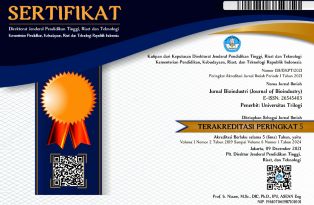ENKAPSULASI BENIH KEDELAI MENGGUNAKAN Pseudomonas fluorescens DENGAN BAHAN PEMBAWA KOMPOS UNTUK MENGENDALIKAN PENYAKIT HAWAR DAUN
Abstract
Soybean leaf blight (Pseudomonas syringae pv glycinea) is one of the important diseases that has the potential to cause production losses of around 11-20%. This study aims to determine the potential of Pseudomonas fluorescens bacteria that is applied through seed encapsulation methods to stimulate soybean plant growth and surpress the development of leaf blight disease. This research was conducted at the Agrotechnopark Jubung greenhouse, University of Jember using a Completely Randomized Design consisting of 5 treatments namely control (P0), encapsulation of P.fluorescens bacteria with compost (P1) formulation, compost + kaolin (P2), compost + talc (P3), and compost + zeolite (P4). The results showed that seed encapsulation with P.fluorescens bacteria made from compost and inorganic carriers was able to reduce the severity of soybean blight disease by up to 40 HSI. Seed encapsulation with P.fluorescens compost + zeolite formulation can increase seed germination, plant height, and number of leaves. The use of talc carrier materials is able to maintain a bacterial population of 6.0 x 103 cfu / ml for up to 28 days of storage.
Keywords: formulation, leaf blight, Pseudomonas fluorescens, Pseudomonas syringae, seed encapsulation
Keywords
Full Text:
PDFDOI: https://doi.org/10.31326/jbio.v1i2.254
DOI (PDF): https://doi.org/10.31326/jbio.v1i2.254.g241
Refbacks
- There are currently no refbacks.
Editorial Office:
Fakultas Bioindustri
Universitas Trilogi
Jl. TMP Kalibata No.1
Jakarta 12760
Copyright Notice:


2.png)






2.png)







